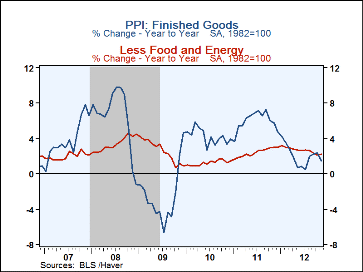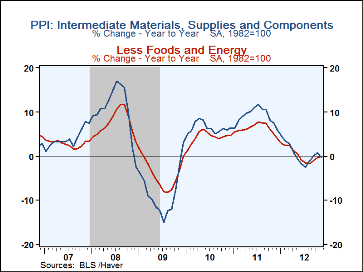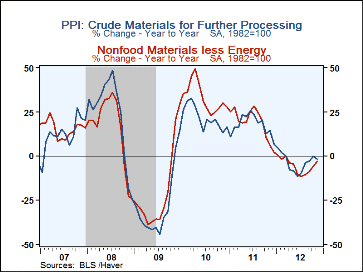 Global| Dec 13 2012
Global| Dec 13 2012U.S. PPI Declines Again With Lower Energy Prices
by:Tom Moeller
|in:Economy in Brief
Summary
The producer price index for finished goods fell 0.8% last month after an unrevised 0.2% October drop. The latest decline contrasted with expectations for a 0.5% drop. Prices excluding food & energy ticked up 0.1% versus expectations [...]
 The producer price index for finished goods fell 0.8% last month
after an unrevised 0.2% October drop. The latest decline contrasted with
expectations for a 0.5% drop. Prices excluding food & energy ticked up
0.1% versus expectations for a 0.2% increase. Falling 4.6% (-1.3% y/y), lower
energy prices again led last month's decline reflecting an 11.2% drop
(+0.1% y/y) in gasoline prices. Higher food prices countered a portion of
these declines with a 1.3% increase (2.6% y/y), the sixth consecutive
month of gain.
The producer price index for finished goods fell 0.8% last month
after an unrevised 0.2% October drop. The latest decline contrasted with
expectations for a 0.5% drop. Prices excluding food & energy ticked up
0.1% versus expectations for a 0.2% increase. Falling 4.6% (-1.3% y/y), lower
energy prices again led last month's decline reflecting an 11.2% drop
(+0.1% y/y) in gasoline prices. Higher food prices countered a portion of
these declines with a 1.3% increase (2.6% y/y), the sixth consecutive
month of gain.
Finished consumer goods prices fell 1.1% (+1.4% y/y) but excluding food & energy, prices ticked up 0.1% (2.6% y/y). Within the components, men's apparel prices rose 5.0% y/y while women's clothing costs edged 0.2% higher y/y. Household appliance prices have gained 3.7% y/y, furniture prices rose 2.2% y/y but passenger car prices slipped 0.2% y/y. Capital equipment prices rose 0.2% last month (1.5% y/y).
Intermediate goods prices fell 1.2% (-0.2% y/y) as energy costs fell 4.9% (-3.2% y/y). Food prices were off 0.3% (+7.2% y/y). Core-intermediate prices slipped 0.1% (-0.1% y/y. Crude goods prices ticked up 0.1% (-1.8% y/y) last month as energy prices were off 0.7% (-9.5% y/y) but food prices increased 0.6% (8.6% y/y). Prices excluding food & energy were up 0.9% (-3.1% y/y).
The PPI data are contained in Haver's USECON database with further detail in PPI and PPIR. The expectations figures are available in the AS1REPNA database.
Drifting Inflation Targets and Stagflation from the Federal Reserve Bank of Kansas City is available here.
| Producer Price Index (%) | Nov | Oct | Sep | Nov Y/Y | 2011 | 2010 | 2009 |
|---|---|---|---|---|---|---|---|
| Finished Goods | -0.8 | -0.2 | 1.1 | 1.4 | 6.0 | 4.2 | -2.5 |
| Less Food & Energy | 0.1 | -0.2 | 0.0 | 2.2 | 2.4 | 1.2 | 2.6 |
| Foods | 1.3 | 0.4 | 0.2 | 2.6 | 6.3 | 3.9 | -1.4 |
| Energy | -4.6 | -0.5 | 4.7 | -1.3 | 15.7 | 13.6 | -17.6 |
| Intermediate Goods | -1.2 | -0.1 | 1.5 | -0.2 | 9.1 | 6.4 | -8.4 |
| Less Food & Energy | -0.1 | 0.0 | 0.6 | -0.1 | 6.2 | 4.3 | -4.2 |
| Crude Goods | 0.1 | 0.9 | 2.8 | -1.8 | 17.4 | 21.4 | -30.3 |
| Less Food & Energy | 0.9 | -1.4 | 1.6 | -3.1 | 18.5 | 32.5 | -23.3 |
Tom Moeller
AuthorMore in Author Profile »Prior to joining Haver Analytics in 2000, Mr. Moeller worked as the Economist at Chancellor Capital Management from 1985 to 1999. There, he developed comprehensive economic forecasts and interpreted economic data for equity and fixed income portfolio managers. Also at Chancellor, Mr. Moeller worked as an equity analyst and was responsible for researching and rating companies in the economically sensitive automobile and housing industries for investment in Chancellor’s equity portfolio. Prior to joining Chancellor, Mr. Moeller was an Economist at Citibank from 1979 to 1984. He also analyzed pricing behavior in the metals industry for the Council on Wage and Price Stability in Washington, D.C. In 1999, Mr. Moeller received the award for most accurate forecast from the Forecasters' Club of New York. From 1990 to 1992 he was President of the New York Association for Business Economists. Mr. Moeller earned an M.B.A. in Finance from Fordham University, where he graduated in 1987. He holds a Bachelor of Arts in Economics from George Washington University.








